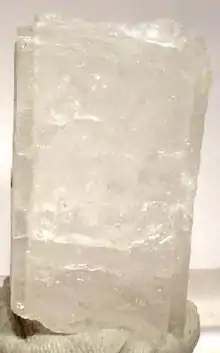Chiolite
Chiolite is a tetragonal-ditetragonal dipyramidal mineral, composed of sodium, fluorine, and aluminium. The name originates from the combination of the Greek words for snow (χιώυ) and stone (λίθος). It is an allusion to its similarity and appearance to cryolite (ice stone).[2] It was first discovered in the Ilmen mountains, Russia, in 1846, but otherwise can be found in Greenland and Virginia. It occurs in some granite pegmatites.[3] It has been a valid species from the same year of its discovery. It consists of 24.89% sodium, 17.53% aluminium, 57.59% fluorine.[4]
| Chiolite | |
|---|---|
 | |
| General | |
| Category | Mineral |
| Formula (repeating unit) | Na5Al3F14 |
| IMA symbol | Cio[1] |
| Strunz classification | 03.CE.05 |
| Dana classification | 11.06.11.01 |
| Crystal system | Tetragonal |
| Crystal class | 4/mmm (4/m 2/m 2/m) - Ditetragonal Dipyramidal |
| Space group | P4/mnc |
| Unit cell | 511.06 ų |
| Identification | |
| Color | Nearly colorless, snow white |
| Twinning | On {011} |
| Cleavage | Perfect on {001}, distinct on {011} |
| Mohs scale hardness | 3.5 - 4 |
| Luster | Vitreous, pearly, greasy |
| Streak | White |
| Diaphaneity | Transparent, translucent |
| Specific gravity | 2.998 |
| Density | 2.998 measured, 2.989 calculated |
| Optical properties | Uniaxial (-) |
| Refractive index | nω = 1.349 nε = 1.342 |
| Birefringence | 0.007 |
References
- Warr, L.N. (2021). "IMA–CNMNC approved mineral symbols". Mineralogical Magazine. 85: 291–320.
- "Chiolite". www.mindat.org. Retrieved 2021-03-05.
- "Chiolite - Occurrence, Properties, and Distribution". AZoMining.com. 2013-02-08. Retrieved 2021-03-05.
- "Chiolite Mineral Data". webmineral.com. Retrieved 2021-04-19.
This article is issued from Wikipedia. The text is licensed under Creative Commons - Attribution - Sharealike. Additional terms may apply for the media files.